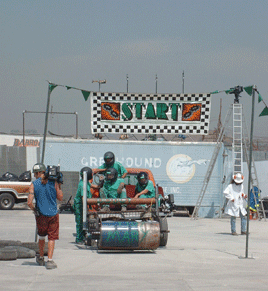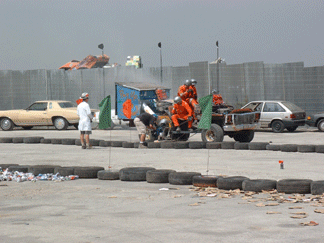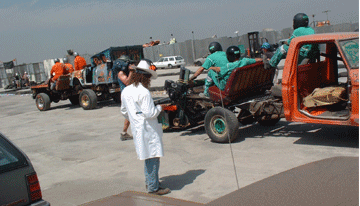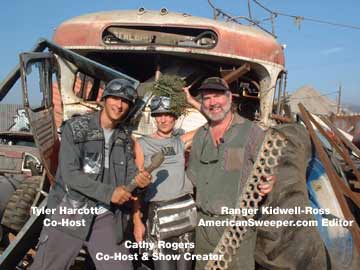

At the end of the build day, when both teams got their sweepers working for the first time each a minute or so before deadline and within seconds of each other, I don't know who were more surprised, the teams, the film crew or the onlookers. Those on the crew were abuzz that this portion of the competition could possibly be so close. Because it was just a few minutes before 10pm, which marked the time when TLC would have to start paying the crew for overtime, everyone was hustled off the set soon after. Not that we weren't all ready to go by that point. Even that late at night it must have been approaching 90 degrees amidst all the metal from the junkyard.
The next day is called the 'safety day,' because that's when the team experts and inhouse engineers go over the machines looking for anything that might pose a safety hazard during the competition phase on the following day. That's when the air sweeper's chassis got its brakes, for example, and the broom sweeper was outfitted with a thin web screening to keep larger debris from being thrown into the faces of the operators.
 The following day, when the competition is held, each team is given a brief amount of time to give their creations a once-over. Then, the long-awaited competition portion begins. The competition was to be held, we learned, in a vacant lot next door to the set. Inside a fenced-in area the crew had set up about a 1/4-mile oval track, using old tire casings to define the inner perimeter. Although the track had 'start' and 'finish' signs, these were more for the camera than anything else, since the same amount of the same type of debris material was put down on each side of the track, rather than have the sweepers racing in the traditional sense.
The following day, when the competition is held, each team is given a brief amount of time to give their creations a once-over. Then, the long-awaited competition portion begins. The competition was to be held, we learned, in a vacant lot next door to the set. Inside a fenced-in area the crew had set up about a 1/4-mile oval track, using old tire casings to define the inner perimeter. Although the track had 'start' and 'finish' signs, these were more for the camera than anything else, since the same amount of the same type of debris material was put down on each side of the track, rather than have the sweepers racing in the traditional sense.
It was decided the competition would be held over the duration of 3 separate rounds, each with different material deposited for pickup. After each round, the sweepers could dump their load into the weigh-in area, then total weight of material collected would determine the winner. Even as those of us who have been around sweepers for years watched the preparations there was a wide degree of speculation about which of the machines would carry the day.
Only the crew knew for sure was what the debris would consist of for each round. That, we all agreed, would be the biggest factor unless one of the sweepers blew an engine or other critical component.

The first round of material consisted of medium-sized chunks of cardboard and then a swath of aluminum cans. Although one team did better (at this point we have to be careful not to give clues as to the eventual winner or the difficulties they encountered during the testing), however we can say it was by no means a runaway by either side. And, a factor that cropped up was that one of the teams had trouble with its pickup system. Between rounds there was a frantic scurrying to get it fixed, which seemed to be accomplished prior to round #2. While both teams worked on getting their sweepers back into better repair, crew members went out onto the track to remove the material that hadn't made it into one or the other of the hoppers (as shown in the photo).
Once the track was cleaned, the next round of material was put onto the track. This challenge was composed of what appeared to be ripped up clothing, a variety of foam picnic plates and plastic cups and, of all things, vegetables! The crew had purchased several crates of vegetables, including heads of lettuce, celery and carrots, and this all went onto the two sides of the track. As soon as the teams saw the daunting combination of material, they gathered together to develop a strategy.
For both, the strategy became concentrating on the heavier weight of the vegetables, since the contest would be judged by weight picked up, rather than spending time on the lighter cloth and foam/plastic items. All of the industry observers saw there was clearly another reason to avoid the cloth: it appeared likely to snarl up either of the sweepers' pickup systems, and perhaps would even bind them such as to make it impossible to continue on to round #3.

Watching the sweeping during round #2 was definitely one of the highlights of the event for me and, I feel sure, most all of the others in the crowd. That's because of what happened when the broom sweeper hit the vegetables. Even though it's traditional to think of what happens when 'stuff' hits a fan, in this case it was the mechanical broom sweeper that brought a roar from the onlookers. Because of the higher-than-needed broom speed revolutions, which there was nothing the team could do anything about, vegetable parts shot upwards of 100 feet into the air. Team members, cameramen and nearby bystanders alike were showered with veggie puree, chunky style. It was outstanding to watch firsthand!
Again, it would be nice if we could tell you how it turned out, but suffice it to say there was still no obvious winner emerging. Again, as though to make things more interesting, the opposite team was the one to have mechanical problems this time. Clearly, everything was riding on the outcome of round #3.
For the last round, the crew spread two piles of material for each sweeper. One course was sticks and brush, the other rocks and sand. Again, pre-race strategy was discussed hurriedly by each team before the horn sounded for the final round. And, at the end of the round, the winner was... the team with the most weight at the end of the episode. Keep an eye on your television guide for when the re-runs of the episode are shown. It's a great show and you certainly won't want to miss it!

© 2005 - 2021 World Sweeper
|
Back to Junkyard Wars HomeBack to Funny BusinessSite Map / Table of Contents |